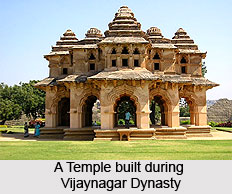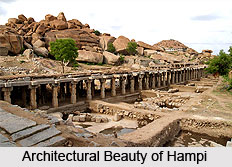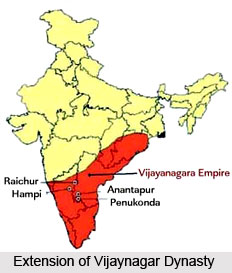 Vijayanagar Empire was a South Indian empire based in the Deccan. This empire lasted for three centuries and successfully prevented the extension of Muslim sultanates in south. The history of Vijayanagar is perhaps the last magnificent chapter in the history of independent India. Founded by Harihara I and his sibling Bukka Raya in 1336, the empire prolonged until 1646. The authority of the kingdom declined in the 1565 after a key military defeat by the Deccan Sultanates. Vijayanagar Empire is appropriately named after its capital city of Vijayanagar, the remarkable ruins of which surround modern
href="https://www.indianetzone.com/hampi_karnataka" class="clsCrossLink" title="Hampi">Hampi, a World Heritage site in modern Karnataka, India. The literature in the local dialects accompanied by the inscriptions of medieval European travellers such as Domingo Paes, Fernao Nuniz and Niccol-Da-Conti endow with significant information regarding the region`s history.
Vijayanagar Empire was a South Indian empire based in the Deccan. This empire lasted for three centuries and successfully prevented the extension of Muslim sultanates in south. The history of Vijayanagar is perhaps the last magnificent chapter in the history of independent India. Founded by Harihara I and his sibling Bukka Raya in 1336, the empire prolonged until 1646. The authority of the kingdom declined in the 1565 after a key military defeat by the Deccan Sultanates. Vijayanagar Empire is appropriately named after its capital city of Vijayanagar, the remarkable ruins of which surround modern
href="https://www.indianetzone.com/hampi_karnataka" class="clsCrossLink" title="Hampi">Hampi, a World Heritage site in modern Karnataka, India. The literature in the local dialects accompanied by the inscriptions of medieval European travellers such as Domingo Paes, Fernao Nuniz and Niccol-Da-Conti endow with significant information regarding the region`s history.
Legacy of the Vijayanagar Empire
The empire`s support facilitated fine arts and literature in order to attain new-fangled pinnacles in Kannada, Telugu, Tamil and Sanskrit languages, while Carnatic Music advanced into its existing structure. The Vijayanagar Empire shaped an era in South Indian history thereby surpassing regionalism with the promotion of Hinduism as a coalescing feature. The empire`s legacy includes many monuments, the best known of which is the group of monuments at Hampi. Multiple temple building traditions in South and Central India were synthesised in the Vijayanagara Architecture style. This synthesis inspired the architecture of the Hindu temples" construction. Efficient functioning of the administration and overseas trade brought new technologies such as water management systems for irrigation.
 History of Vijayanagar Empire
History of Vijayanagar Empire
Several theories have been projected claiming the basis of the Vijayanagar Empire. A few assert that Harihara I and Bukka Raya I, the originators of the kingdom, were the ones primarily allied to the Kakatiya dynasty who acquired power of the northern regions of the Hoysala Empire through its decline. Further, historians put forth that they were Kannadigas and commanders in the army of the Hoysala Empire posted in the Tungabhadra River region to charge off Muslim incursions commencing from Northern India. Irrespective of their derivation, historians concur that the initiators were backed and enthused by Vidyaranya, a saint at the Sringeri monastery to wrestle the Muslim incursion of South India. Inscriptions by foreign travellers during the late medieval era pooled with topical excavations in the Vijayanagar region have revealed the required details concerning the empire"s history, ramparts, scientific expansions and architectural advancements.
Before the early 14th-century rise of the Vijayanagara Empire, the Hindu states of the Deccan – the Yadava Empire of Devagiri, the Kakatiya dynasty of Warangal, the Pandyan Empire of Madurai were raided and attacked by Muslims from the north. By the year 1336 the upper Deccan region (modern day Telangana and Maharashtra) had been defeated by armies of Alauddin Khilji and Muhammad bin Tughluq of the Delhi Sultanate.
 Governance of the Vijayanagar Empire
Governance of the Vijayanagar Empire
In Vijayanagar, the King was the ultimate authority and he was assisted by a cabinet of pradhanas headed by a Mahapradhana. All high-ranking ministers and officers were required to have proper military training. A secretariat was appointed near the king`s palace which employed officers to maintain records. At the lower administrative levels, wealthy feudal landlords (Goudas) looked over the work of the accountants (Karanikas or Karnam) and guards (Kavalu). The palace administration was divided into 72 departments each of them having several female attendants who were trained to handle minor administrative matters. The whole empire was divided into five main rajyas each of which was further divided into regions. The regions were divided into counties with the subdivision of municipalities. The capital city of this empire was totally dependent upon the water supply system. Contemporary inscription of that time brought the fact that huge tanks were constructed by the labours.
Economy of Vijayanagar Empire
The economy of this empire was largely dependent upon agriculture. Coconut was the principal cash crop. Spices such as turmeric, pepper, cardamom and ginger grew in the remote Malnad hill region and were transported to the city for business. Land ownership was important in the empire. The tenant farmers were given the right of part ownership of the land. East coast trade was prospering. Goods arrived from Golkonda where rice, millet, pulses and tobacco were grown on a large scale. Dye crops of indigo were produced for the weaving industry. The main imports on the east coast were non-ferrous metals, camphor, porcelain, silk and luxury goods.
Culture of Vijayanagar Empire
In Vijayanagar Empire, the Hindu caste system was prevalent and strictly followed. Each community in the caste system was represented by an elderly local body. These elders set the rules and regulations that were implemented with the help of royal decrees. Untouchability was a part of the caste system. Brahmins enjoyed higher class reputation. Sati was common in use. Wrestling was an important male preoccupation for sport and entertainment. The Bhakti Movement was active during this time.
 The socio-religious movements such as Lingayatism, provided for flexible social norms by which the women had to abide. South Indian women were already actively involved in matters such as administration, business, trade, and involvement in the fine arts. The Vijayanagara kings were tolerant of all religions. The kings used titles such as Gobrahamana Pratipalanacharya (meaning, "protector of cows and Brahmins") and Hindurayasuratrana (meaning, "upholder of Hindu faith") that proved their intention of protecting Hinduism and yet at the same time they were staunch in their tolerance towards Islam.
The socio-religious movements such as Lingayatism, provided for flexible social norms by which the women had to abide. South Indian women were already actively involved in matters such as administration, business, trade, and involvement in the fine arts. The Vijayanagara kings were tolerant of all religions. The kings used titles such as Gobrahamana Pratipalanacharya (meaning, "protector of cows and Brahmins") and Hindurayasuratrana (meaning, "upholder of Hindu faith") that proved their intention of protecting Hinduism and yet at the same time they were staunch in their tolerance towards Islam.
Kannada, Telugu and Tamil were the languages that were used in the respective regions of the empire. More than 7000 inscriptions have been recovered, half of which are in Kannada, the remaining in Telugu, Tamil and Sanskrit.
Architecture of Vijayanagar Empire
Vijayanagara architecture is a combination of the Chalukya, Hoysala, Pandya and Chola styles. The hallmark of the empire"s architecture is the ornate pillared Kalyanamantapa (marriage hall), Vasanthamantapa (open pillared halls) and the Rayagopura (tower). The locally available hard granite was used by the artisans because of its durability. This was because the kingdom was under constant threat of invasions. The monuments of the Vijayanagar Empire are spread over the entire Southern India. The vast open-air theatre of monuments at Vijayanagara is a UNESCO World Heritage Site.



















